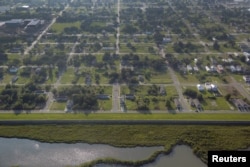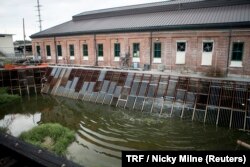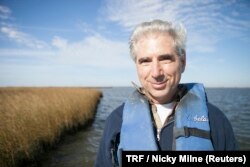Sitting on his porch in the Lower Ninth Ward of New Orleans, Otis Tucker cuts a lone figure on a street punctuated with large empty spaces — the shadows of homes lost to Hurricane Katrina.
Tucker lives in the part of the Louisiana city most devastated by the powerful storm and its aftermath in 2005, when levees designed to protect the city from flooding failed.
Many residents of the poor neighborhood have struggled to return after fleeing Katrina.
Lack of funds to come home and rebuild, coupled with developers swiftly moving in, and gentrification of this predominantly black, lower-income area, have left scars.
Today, broken windows and overgrown weeds pepper abandoned homes, and the angry barking of a dog interrupts the silence.
"There were families here, there were kids in the street playing football, and there were neighbors," said Tucker, who was born and bred in the neighborhood. "And that went away overnight. It just got washed away."
Since being battered by Katrina — which killed more than 18,000 people and destroyed over 800,000 homes — New Orleans has started adapting to extreme weather, which scientists predict will worsen as the planet warms.
Arthur Johnson, chief executive officer of the Center for Sustainable Engagement and Development in the Lower Ninth Ward, said disaster preparation "has become the norm, not the exception."
Evacuation centers have been built, homes have been raised higher, and solar panels installed on roofs.
The center teaches the community here to create "rain gardens" that capture rainwater for re-use. And with much of the soil still contaminated by toxic chemicals such as arsenic post-Katrina, local people are shown how to grow orchards and plant seeds in troughs above the ground.
Working with water
On a larger scale, New Orleans-based architects Waggonner and Ball have played a lead role in developing the Greater New Orleans Urban Water Plan.
Funded by the Louisiana Office of Community Development, the plan addresses flooding from heavy rainfall, as well as ground subsidence caused by pumping out storm water.
Company president David Waggonner, who travels extensively to share his experiences, told Reuters the city has much to learn from Amsterdam.
New Orleans has relied on an outdated method of pumping out excess water, and needs to rethink if it is to survive, he explained at his desk, which sports a model of the city's streets and extensive pump stations.
"The city needs to learn to live with water — creating a space for water to fall and gradually go into the soil and back into the sky," he said.
One way to do this is by creating "aesthetic blue ways and green ways," he added.
These include the Mirabeau Water Garden in Gentilly district — 25 acres (10 hectares) that will be designed to divert water from canals and capture storm runoff — as well as other green infrastructure such as new parks and redesigned streets with trees, grassy areas and ponds.
Coastal master plan
New Orleans is the state's largest city, with a population of just under 400,000, but Louisiana as a whole is responding rapidly to ongoing land loss and an increased risk of flooding.
According to a study released by the U.S. Geological Society, Louisiana is suffering loss of its wetlands at a rate of a football field an hour.
"After Hurricane Katrina, people started to get really serious about coastal issues," said Denise Reed, research professor at the University of New Orleans and a key technical adviser on the state-led Coastal Master Plan.
The first such master plan was mandated by the state legislature following Katrina, but earlier versions were more of a "wish list," Reed said.
The latest plan — drawn up by the Coastal Protection and Restoration Authority and approved in 2017 — outlines priority projects requiring investment of $50 billion.
The money is needed to rebuild barrier islands and wetlands, move water and sediment from the Mississippi River to make new marshes, construct levees and flood gates, raise houses, and in some cases buy property so homeowners can move to a safer place.
"We all have to be creative with expenditure," Reed told Reuters.
"In the area where I live, we've passed a sales tax, so every time you go to the store to buy something, a penny or two goes into a pot used for building a levee."
Sinking land, rising seas
In a boat heading to the marshlands off the coast of Cocodrie, a shrimping and crabbing village in southeast Louisiana, Alex Kolker, associate professor at the Louisiana Universities Marine Consortium, pointed to large industrial structures protruding from the water.
"Something in the order of 20 to 30 percent of the nation's oil infrastructure is in the Gulf of Mexico," said the oceanologist and coastal geologist. "It's a multibillion, if not multitrillion investment — and much of it is at, or very near, sea level."
The extractive industry is at risk from rising seas and storms, but is also a key reason why Louisiana is subsiding, he explained. When oil and gas are taken from the ground, a vacuum is created and the land sinks into it.
Research by Kolker and others shows that much of the subsidence affecting Louisiana's coast relates to these patterns of oil and gas withdrawal.
In the last century, most of the increase in the water level was due to the ground sinking, but as global sea levels rise, that is changing.
"The biggest variable for the future of Louisiana is sea-level rise," said Kolker. He pointed to predictions the United States will see an average increase of about 1 cm (0.39 inches) a year by 2050.
"Those are the kind of rates that we experienced at the end of last Ice Age. That would be very, very disruptive — to New York, to London and Tokyo," he said.
Against that background, lessons being learned in Louisiana will be invaluable for the rest of the world, Kolker believes.
Back in New Orleans, Tucker's community has already experienced the full force of wild weather.
Even though he is aware that those with fewer means may struggle to be as resilient as wealthier residents, he is determined not to be cowed by the growing threat.
"I know that the water's not going anywhere," he said. "But politicians, developers, poor people, rich people, people with many resources, people with little — we're all in this together."













